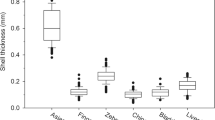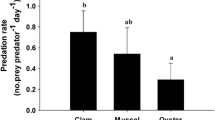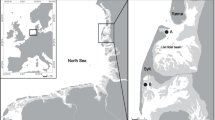Abstract.
Information concerning the way juvenile crabs choose their diet from a variety of prey types can be useful for a better understanding of community dynamics, as well as for the adequate management of natural resources. Prey size and species selection by juvenile Carcinus maenas (15–35 mm carapace width, CW) and Cancer pagurus (20–40 mm CW) feeding on four bivalves of contrasting shell morphology were investigated. When offered a wide size range of Mytilus edulis, Ostrea edulis, Crassostrea gigas, and Cerastoderma edule presented individually, crabs generally showed evidence of size-selective predation. Cancer pagurus selected larger mussels relative to the size of their chelae (relative prey size, RPS) than did Carcinus maenas of similar and even larger carapace width. However, the RPS of selected O. edulis and Cerastoderma edule were similar for all crabs, suggesting that certain prey features constitute effective barriers even to the powerful chelae of Cancer pagurus. When offered a wide size range of mussels and oysters simultaneously, all crabs consistently selected mussels. When offered O. edulis and Crassostrea gigas, crabs consumed both these oyster species in similar numbers. Carcinus maenas consumed similar numbers of mussels and cockles; Cancer pagurus, however, showed no preference for either prey in the smaller size classes but selected more mussels than cockles as prey increased in size. Although previous studies report that adult Carcinus maenas select prey species according to their profitability (amount of food ingested per unit of handling time, milligrams per second), consumption rates of the size classes of prey selected by juvenile shore crabs did not always parallel prey value. Although variations in crab strength can account for many of the differences between the foraging strategy of juvenile and adult C. maenas, our results suggest that juvenile crabs are less species selective than adults as a result of the restrictions imposed on small individuals that have limited access to larger prey.
Similar content being viewed by others
Author information
Authors and Affiliations
Additional information
Electronic Publication
Rights and permissions
About this article
Cite this article
Mascaró, .M., Seed, .R. Foraging behavior of juvenile Carcinus maenas (L.) and Cancer pagurus L.. Marine Biology 139, 1135–1145 (2001). https://doi.org/10.1007/s002270100677
Received:
Accepted:
Issue Date:
DOI: https://doi.org/10.1007/s002270100677




